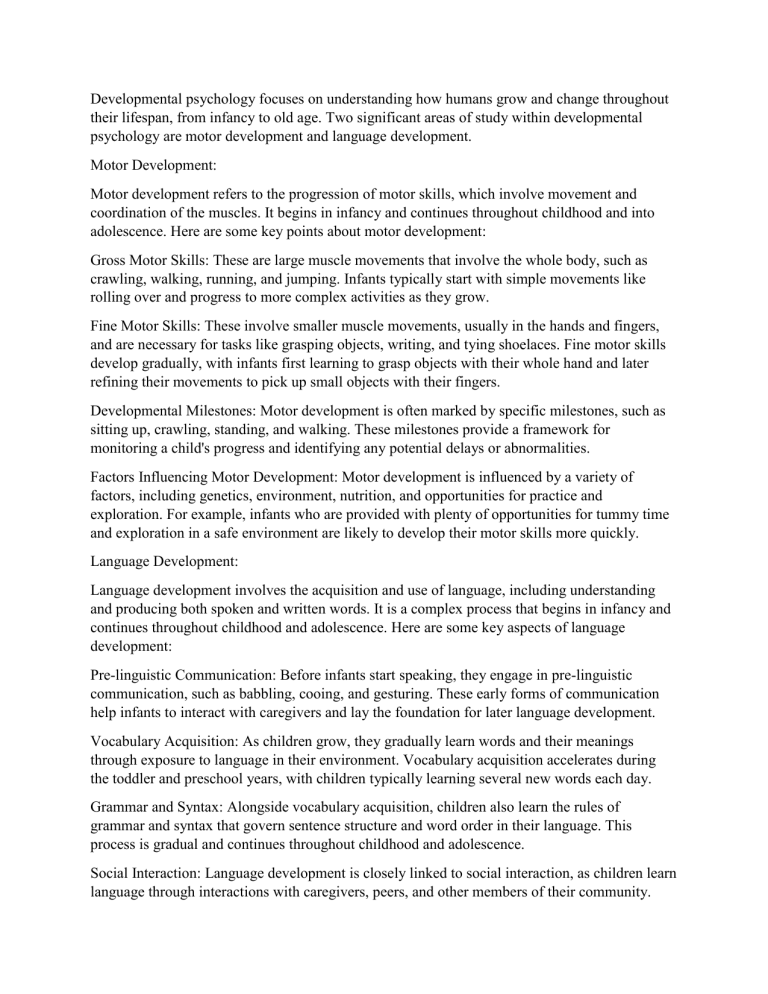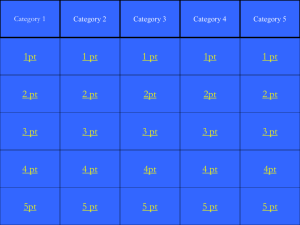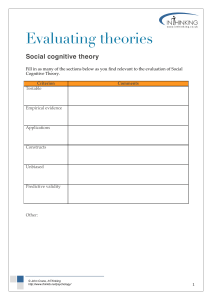
Developmental psychology focuses on understanding how humans grow and change throughout their lifespan, from infancy to old age. Two significant areas of study within developmental psychology are motor development and language development. Motor Development: Motor development refers to the progression of motor skills, which involve movement and coordination of the muscles. It begins in infancy and continues throughout childhood and into adolescence. Here are some key points about motor development: Gross Motor Skills: These are large muscle movements that involve the whole body, such as crawling, walking, running, and jumping. Infants typically start with simple movements like rolling over and progress to more complex activities as they grow. Fine Motor Skills: These involve smaller muscle movements, usually in the hands and fingers, and are necessary for tasks like grasping objects, writing, and tying shoelaces. Fine motor skills develop gradually, with infants first learning to grasp objects with their whole hand and later refining their movements to pick up small objects with their fingers. Developmental Milestones: Motor development is often marked by specific milestones, such as sitting up, crawling, standing, and walking. These milestones provide a framework for monitoring a child's progress and identifying any potential delays or abnormalities. Factors Influencing Motor Development: Motor development is influenced by a variety of factors, including genetics, environment, nutrition, and opportunities for practice and exploration. For example, infants who are provided with plenty of opportunities for tummy time and exploration in a safe environment are likely to develop their motor skills more quickly. Language Development: Language development involves the acquisition and use of language, including understanding and producing both spoken and written words. It is a complex process that begins in infancy and continues throughout childhood and adolescence. Here are some key aspects of language development: Pre-linguistic Communication: Before infants start speaking, they engage in pre-linguistic communication, such as babbling, cooing, and gesturing. These early forms of communication help infants to interact with caregivers and lay the foundation for later language development. Vocabulary Acquisition: As children grow, they gradually learn words and their meanings through exposure to language in their environment. Vocabulary acquisition accelerates during the toddler and preschool years, with children typically learning several new words each day. Grammar and Syntax: Alongside vocabulary acquisition, children also learn the rules of grammar and syntax that govern sentence structure and word order in their language. This process is gradual and continues throughout childhood and adolescence. Social Interaction: Language development is closely linked to social interaction, as children learn language through interactions with caregivers, peers, and other members of their community. Social interactions provide opportunities for children to practice using language in meaningful contexts and to learn from the feedback they receive. Individual Differences: There is considerable variation in the rate and pattern of language development among children. Factors such as genetics, exposure to language, and individual differences in cognitive abilities can influence how quickly children acquire language skills. Both motor and language development are critical aspects of child development, and they often interact with each other. For example, infants may use gestures and vocalizations to communicate their needs before they have developed the ability to speak, and motor skills such as pointing and reaching play a role in language development. Understanding these developmental processes is essential for parents, caregivers, and educators to support children's growth and learning effectively. In summary, developmental psychology examines how individuals progress through various stages of growth and change across their lifespan. Two important aspects of this development are motor and language development: Motor Development: Involves the progression of physical abilities and coordination. Includes gross motor skills (larger muscle movements) and fine motor skills (precise movements). Developmental milestones include rolling over, sitting up, crawling, and walking. Influenced by genetics, environment, nutrition, and practice opportunities. Language Development: Involves the acquisition and use of language for comprehension, expression, and communication. Progresses through stages such as pre-linguistic communication, vocabulary acquisition, and grammar/syntax development. Social interaction plays a significant role in language development. Individual differences exist, influenced by genetics, environment, and learning styles. Understanding motor and language development is essential for assessing a child's progress and providing appropriate support. These areas of development interact with each other and with other aspects of development, contributing to a child's overall growth and wellbeing. In developmental psychology, cognitive development and socioemotional development are two significant areas of study that focus on different aspects of a person's growth and maturation from infancy through adulthood. Here's an overview of each: Cognitive Development: Cognitive development refers to the growth and changes in a person's intellectual abilities, including thinking, reasoning, problem-solving, memory, and language. This area of study is heavily influenced by the work of Jean Piaget, who proposed a stage theory of cognitive development. Here are some key points about cognitive development: Piaget's Stages: Piaget's theory outlines four main stages of cognitive development: sensorimotor, preoperational, concrete operational, and formal operational. Each stage is characterized by distinct cognitive abilities and ways of understanding the world. Assimilation and Accommodation: According to Piaget, cognitive development occurs through a process of assimilation and accommodation. Assimilation involves incorporating new information into existing cognitive schemas, while accommodation involves modifying existing schemas to fit new information. Information Processing: Another perspective on cognitive development focuses on information processing, which views cognitive development as a gradual increase in the ability to process and organize information. This approach emphasizes attention, memory, and problem-solving skills. Social and Cultural Influences: Cognitive development is also influenced by social and cultural factors. For example, Vygotsky's sociocultural theory emphasizes the role of social interactions and cultural tools (such as language and symbols) in cognitive development. Individual Differences: There is considerable variation in cognitive development among individuals, influenced by factors such as genetics, environment, and experiences. Some children may develop certain cognitive skills more quickly or proficiently than others. Socioemotional Development: Socioemotional development refers to the growth and changes in a person's social and emotional functioning, including their relationships with others, emotional regulation, and understanding of themselves and others. This area of study encompasses various theories and concepts, including attachment theory and Erik Erikson's psychosocial stages. Here are some key points about socioemotional development: Attachment: Attachment theory, developed by John Bowlby, emphasizes the importance of early relationships with caregivers in shaping a child's socioemotional development. Secure attachment is associated with positive outcomes in areas such as emotional regulation, social competence, and mental health. Emotional Development: Socioemotional development involves the understanding and expression of emotions, as well as the ability to regulate emotions effectively. Children gradually learn to identify and label their emotions, understand the emotions of others, and manage their emotional responses. Social Skills: Socioemotional development also includes the development of social skills, such as communication, cooperation, empathy, and perspective-taking. These skills are essential for building and maintaining relationships with others. Self-Concept and Identity: As children grow, they develop a sense of self-concept and identity, which involves understanding who they are, what they value, and how they fit into their social and cultural context. Erikson's psychosocial stages outline the challenges and conflicts that individuals face at different stages of life related to identity development. Cultural Influences: Socioemotional development is shaped by cultural norms, values, and expectations regarding emotions, relationships, and social roles. Cultural differences can influence how emotions are expressed, the nature of social relationships, and the development of identity. Both cognitive development and socioemotional development are interconnected and influence each other throughout the lifespan. For example, cognitive abilities such as perspective-taking and theory of mind play a role in understanding and navigating social interactions, while socioemotional factors such as emotions and relationships can impact cognitive processes such as attention and memory. Understanding these developmental processes is essential for promoting healthy growth and well-being across the lifespan. In summary, developmental psychology encompasses the study of various aspects of human growth and maturation from infancy through adulthood. Two significant areas of study within developmental psychology are cognitive development and socioemotional development: Cognitive Development involves the growth and changes in intellectual abilities such as thinking, reasoning, problem-solving, memory, and language. This area includes theories such as Piaget's stages of cognitive development, which emphasize the gradual acquisition of cognitive skills through assimilation and accommodation. Cognitive development is influenced by social, cultural, and individual factors, and it plays a crucial role in shaping how individuals understand and interact with the world around them. Socioemotional Development focuses on the growth and changes in social and emotional functioning, including relationships with others, emotional regulation, and self-concept. This area encompasses theories like attachment theory and Erikson's psychosocial stages, which highlight the importance of early relationships and the development of a sense of identity. Socioemotional development is shaped by cultural norms and individual experiences and influences how individuals navigate social interactions, manage emotions, and form meaningful relationships. Both cognitive development and socioemotional development are interconnected and influence each other throughout the lifespan, contributing to overall human development and well-being. Understanding these developmental processes is essential for supporting healthy growth and promoting positive outcomes across various domains of life.




